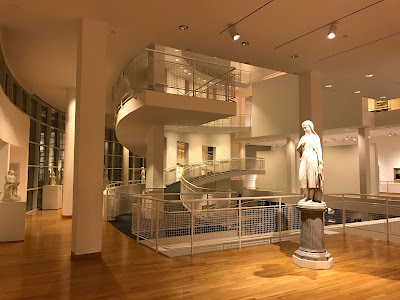I was recently in Atlanta, Georgia and had the chance to swing by one of my favorite sketching locations - the High Museum of Art. The building, designed by architect Richard Meier and opened in 1983, is itself a sculptural work of art:
The High Museum, part of the Woodruff Arts Center, houses a splendid collection of European and American sculptures from the late 19th Century.
My first subject is a bust of the French writer Honoré de Balzac (1799-1850) - one of the founders of Realism in French literature. The bust was sculpted by Pierre-Eugène-Emile Hébert (1823-1893) in 1877:
I prefer to do these types of proportional studies using just a pencil and paper and I don't typically even worry about using an eraser - just leaving my guidelines visible as I go. I avoid other tools and measuring devices so I can focus on training my eye and hand to see and record proportions and shapes as accurately as possible.
First I try to capture the big shapes and proportions as accurately as possible:
Then I begin to subdivide to capture the next level of detail. I concentrate on finding the shapes of the outlines of both the forms and the shadows:
I proceed across the entire drawing briskly but methodically, trying to make sure each line is properly located in reference to the others:
Working in this manner, a likeness of the sculpture begins to emerge:
For this type of proportional study, I do only minimal modeling of the various tones within the shadows, and instead focus primarily on the precise perimeter shapes of the shadows:
I constantly look back and forth from my sketch to the sculpture being drawn in order to compare the shapes, angles and proportions.
This is wonderful exercise for both the eye and my sense of proportion. I did this sketch exercise in about 45 minutes, and I like to move pretty quickly so I can do more than one sketch in a museum visit when possible:
I had the opportunity to do 2 more sketches in a similar manner on this visit to the High Museum.
Next was a sketch of Flora by the American sculptor Chauncey Bradley Ives (1810-1894):

And then a sketch of Proserpine by one of my very favorite American sculptors, Hiram Powers (1805-1873):













Nice sketches James and I enjoyed meeting you at CNU Savannah. Out of interest do you ever copy Bargue plates as a drawing exercise?
ReplyDelete